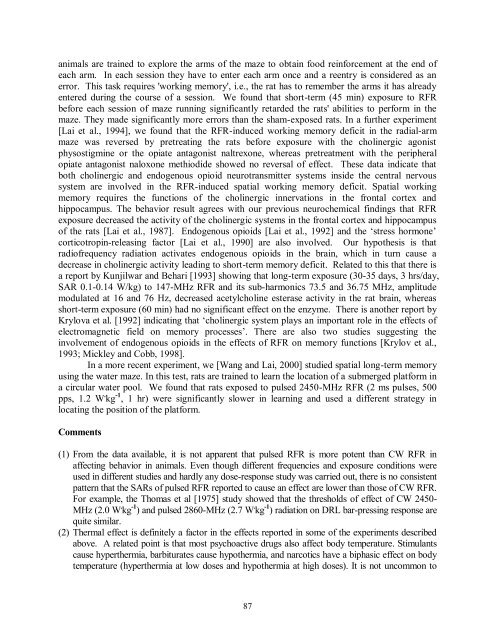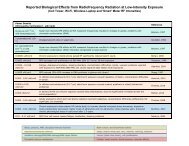Evidence for Effects on Neurology and Behavior - BioInitiative Report
Evidence for Effects on Neurology and Behavior - BioInitiative Report
Evidence for Effects on Neurology and Behavior - BioInitiative Report
You also want an ePaper? Increase the reach of your titles
YUMPU automatically turns print PDFs into web optimized ePapers that Google loves.
animals are trained to explore the arms of the maze to obtain food rein<str<strong>on</strong>g>for</str<strong>on</strong>g>cement at the end of<br />
each arm. In each sessi<strong>on</strong> they have to enter each arm <strong>on</strong>ce <strong>and</strong> a reentry is c<strong>on</strong>sidered as an<br />
error. This task requires 'working memory', i.e., the rat has to remember the arms it has already<br />
entered during the course of a sessi<strong>on</strong>. We found that short-term (45 min) exposure to RFR<br />
be<str<strong>on</strong>g>for</str<strong>on</strong>g>e each sessi<strong>on</strong> of maze running significantly retarded the rats' abilities to per<str<strong>on</strong>g>for</str<strong>on</strong>g>m in the<br />
maze. They made significantly more errors than the sham-exposed rats. In a further experiment<br />
[Lai et al., 1994], we found that the RFR-induced working memory deficit in the radial-arm<br />
maze was reversed by pretreating the rats be<str<strong>on</strong>g>for</str<strong>on</strong>g>e exposure with the cholinergic ag<strong>on</strong>ist<br />
physostigmine or the opiate antag<strong>on</strong>ist naltrex<strong>on</strong>e, whereas pretreatment with the peripheral<br />
opiate antag<strong>on</strong>ist nalox<strong>on</strong>e methiodide showed no reversal of effect. These data indicate that<br />
both cholinergic <strong>and</strong> endogenous opioid neurotransmitter systems inside the central nervous<br />
system are involved in the RFR-induced spatial working memory deficit. Spatial working<br />
memory requires the functi<strong>on</strong>s of the cholinergic innervati<strong>on</strong>s in the fr<strong>on</strong>tal cortex <strong>and</strong><br />
hippocampus. The behavior result agrees with our previous neurochemical findings that RFR<br />
exposure decreased the activity of the cholinergic systems in the fr<strong>on</strong>tal cortex <strong>and</strong> hippocampus<br />
of the rats [Lai et al., 1987]. Endogenous opioids [Lai et al., 1992] <strong>and</strong> the ‘stress horm<strong>on</strong>e’<br />
corticotropin-releasing factor [Lai et al., 1990] are also involved. Our hypothesis is that<br />
radiofrequency radiati<strong>on</strong> activates endogenous opioids in the brain, which in turn cause a<br />
decrease in cholinergic activity leading to short-term memory deficit. Related to this that there is<br />
a report by Kunjilwar <strong>and</strong> Behari [1993] showing that l<strong>on</strong>g-term exposure (30-35 days, 3 hrs/day,<br />
SAR 0.1-0.14 W/kg) to 147-MHz RFR <strong>and</strong> its sub-harm<strong>on</strong>ics 73.5 <strong>and</strong> 36.75 MHz, amplitude<br />
modulated at 16 <strong>and</strong> 76 Hz, decreased acetylcholine esterase activity in the rat brain, whereas<br />
short-term exposure (60 min) had no significant effect <strong>on</strong> the enzyme. There is another report by<br />
Krylova et al. [1992] indicating that ‘cholinergic system plays an important role in the effects of<br />
electromagnetic field <strong>on</strong> memory processes’. There are also two studies suggesting the<br />
involvement of endogenous opioids in the effects of RFR <strong>on</strong> memory functi<strong>on</strong>s [Krylov et al.,<br />
1993; Mickley <strong>and</strong> Cobb, 1998].<br />
In a more recent experiment, we [Wang <strong>and</strong> Lai, 2000] studied spatial l<strong>on</strong>g-term memory<br />
using the water maze. In this test, rats are trained to learn the locati<strong>on</strong> of a submerged plat<str<strong>on</strong>g>for</str<strong>on</strong>g>m in<br />
a circular water pool. We found that rats exposed to pulsed 2450-MHz RFR (2 ms pulses, 500<br />
pps, 1.2 W . kg -1 , 1 hr) were significantly slower in learning <strong>and</strong> used a different strategy in<br />
locating the positi<strong>on</strong> of the plat<str<strong>on</strong>g>for</str<strong>on</strong>g>m.<br />
Comments<br />
(1) From the data available, it is not apparent that pulsed RFR is more potent than CW RFR in<br />
affecting behavior in animals. Even though different frequencies <strong>and</strong> exposure c<strong>on</strong>diti<strong>on</strong>s were<br />
used in different studies <strong>and</strong> hardly any dose-resp<strong>on</strong>se study was carried out, there is no c<strong>on</strong>sistent<br />
pattern that the SARs of pulsed RFR reported to cause an effect are lower than those of CW RFR.<br />
For example, the Thomas et al [1975] study showed that the thresholds of effect of CW 2450-<br />
MHz (2.0 W . kg -1 ) <strong>and</strong> pulsed 2860-MHz (2.7 W . kg -1 ) radiati<strong>on</strong> <strong>on</strong> DRL bar-pressing resp<strong>on</strong>se are<br />
quite similar.<br />
(2) Thermal effect is definitely a factor in the effects reported in some of the experiments described<br />
above. A related point is that most psychoactive drugs also affect body temperature. Stimulants<br />
cause hyperthermia, barbiturates cause hypothermia, <strong>and</strong> narcotics have a biphasic effect <strong>on</strong> body<br />
temperature (hyperthermia at low doses <strong>and</strong> hypothermia at high doses). It is not uncomm<strong>on</strong> to<br />
87



